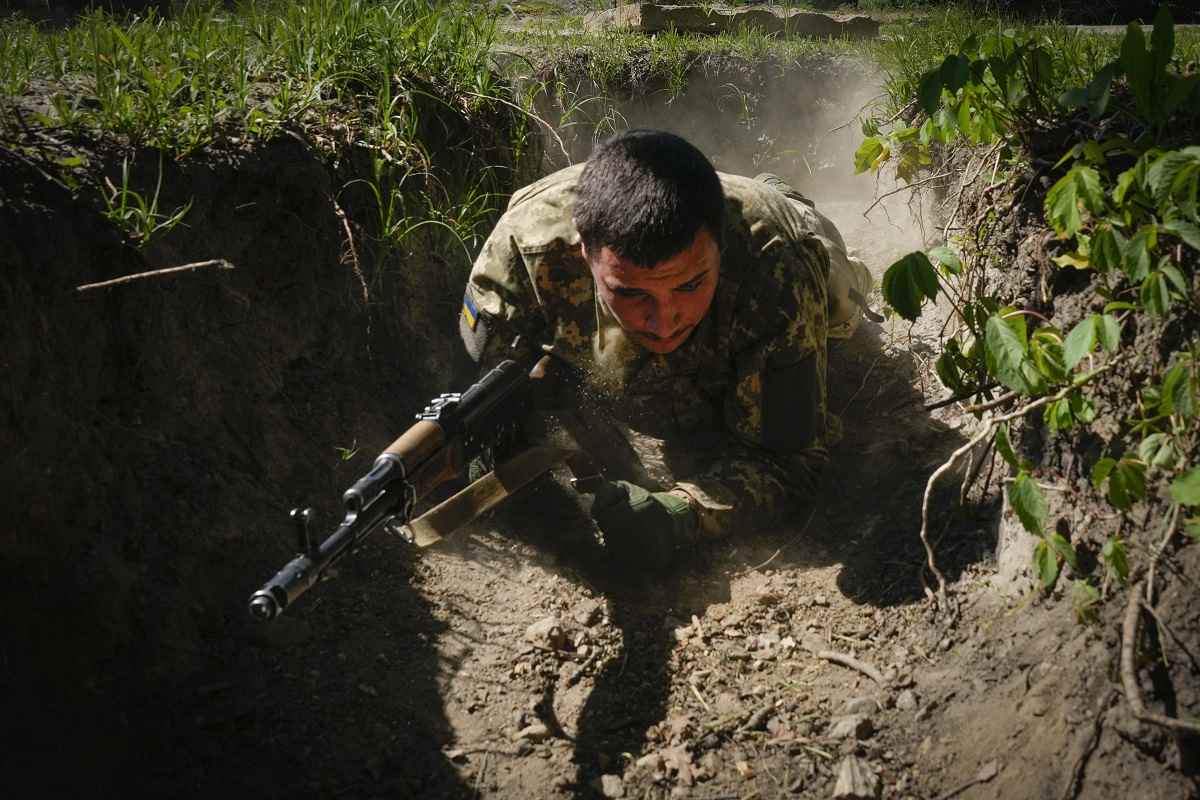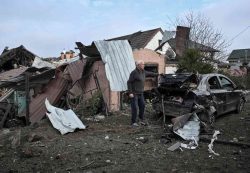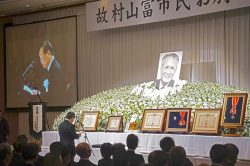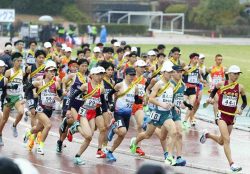Ukraine’s Divisive Mobilization Law Comes into Force as a New Russian Push Strains Front-Line Troops

A newly recruited soldier of the 3rd assault brigade trains, in Kyiv, Ukraine, Friday, May 17, 2024.
13:58 JST, May 19, 2024
KYIV, Ukraine (AP) — A divisive mobilization law in Ukraine came into force on Saturday, as Kyiv struggles to boost troop numbers after Russia launched a new offensive that some fear could close in on Ukraine’s second-largest city.
The legislation, which was watered down from its original draft, will make it easier to identify every conscript in the country. It also provides incentives to soldiers, such as cash bonuses or money toward buying a house or car, that some analysts say Ukraine cannot afford.
Lawmakers dragged their feet for months and only passed the law in mid-April, a week after Ukraine lowered the age for men who can be drafted from 27 to 25. The measures reflect the growing strain that more than two years of war with Russia has had on Ukraine’s forces, who are trying to hold the front lines in fighting that has sapped the country’s ranks and stores of weapons and ammunition.
Ukrainian President Volodymyr Zelenskyy also signed two other laws Friday, allowing prisoners to join the army and increasing fines for draft dodgers fivefold. Russia enlisted its prisoners early on in the war, and personnel shortages compelled Ukraine to adopt the new, controversial measures.
CONCERNS ABOUT THE LAW
Oleksii, 68, who runs a car repair shop in Kyiv, worries his business will have to shut down as he expects 70% of his workers will be mobilized. He asked that only his first name be used to allow him to speak freely.
“With the new law, people will be mobilized and we will have to shut down and stop paying taxes,” Oleksii told The Associated Press on Saturday. He said it’s very difficult to replace workers because of their specialized skills. Most of them are already in the armed forces, he said, adding that the law is “unfair” and “unclear.”
Even essential municipal services will be affected. Viktor Kaminsky, the head of a municipal service department in Kyiv that fits households with heating and repairs utilities in public buildings, said he will struggle to replace mobilized staff and meet demand, even though the law allows him to retain half of workers deemed fit for service.
He said 60 of the 220 people working in Kaminsky’s department will be eligible to be called up. “If they take 30 people from what we have, the problem is we don’t have anyone to replace them,” he said.
“There are pros and cons to this law,” Kaminsky said. “It’s hard to avoid the mobilization process now, compared to before when people were trying to get around it.” But, he said, it would be better if essential workers like his were granted more exemptions.
Meanwhile, Oleksii Tarasenko, a deputy commander of a Ukrainian assault battalion, told AP that his men felt “awful” about the law’s failure to address the issue of demobilization. Although many Ukrainian troops have been fighting since the war’s early days, it remains unclear when and how they might be relieved of duty.
“It feels like a cruel injustice towards people who have been fighting for two years, and of course, it has a highly negative effect on the psychological state of soldiers and their families,” Tarasenko said.
Early drafts of the law envisaged the demobilization of troops after 36 months, and the rotation of those serving on the front line for more than half a year. These clauses were dropped following a last-minute appeal by Ukraine’s military leadership, concerned that the armed forces would be left without their best-trained and most experienced troops. The Ukrainian Defense Ministry is working on a separate demobilization law.
Tarasenko said that despite their weariness, his comrades could see the generals’ point.
“We already see how many people are lacking, especially professional troops in the units. And simply allowing such professional people who have been through a lot to demobilize would be wrong,” he said.
UKRAINIAN FORCES UNDER STRAIN
Ukraine has struggled for months to replenish depleted forces, as Russian troops are pushing ahead with a ground offensive that opened a new front in the northeast and put further pressure on Kyiv’s overstretched military. After weeks of probing, Moscow launched the new push knowing that Ukraine suffered personnel shortages, and that its forces have been spread thin in the northeastern Kharkiv region.
Moscow’s forces have pummeled Kharkiv with strikes in recent weeks, hitting civilian and energy infrastructure and prompting angry accusations from Zelenskyy that the Russian leadership sought to reduce the city to rubble. Mayor Ihor Terekhov said that five people were injured on Saturday in a Russian airstrike that hit a residential area. On Friday, Terekhov reported that Russian guided bombs killed at least three Kharkiv residents and injured 28 others.
Moscow denies deliberately targeting civilians, but thousands have died or suffered injuries in the more than 27 months of fighting.
Kharkiv regional Gov. Ihor Syniehubov on Saturday said that nearly 10,000 civilians had to be evacuated from front-line areas near the Russian border. Only 100 residents remain in Vovchansk, the border town at the center of Moscow’s grinding push that’s now largely in ruins. The town had a pre-war population of over 17,400.
The U.S. last week announced a new $400 million package of military aid for Ukraine, and President Joe Biden has promised that he would rush badly needed weaponry to the country to help it stave off Russian advances. Still, only small batches of U.S. military aid have started to trickle into the front line, according to Ukrainian military commanders, who said it will take at least two months before supplies meet Kyiv’s needs to hold the line.
VOLUNTEERS AND RUNAWAYS
Rusyn is the head of recruitment for the 3rd Assault Brigade, one of the most popular among Ukrainian volunteers. He told AP that he saw a 15% increase in men joining the brigade, which fights in eastern Ukraine, in the past months. Most recruits are aged between 23-25, he said. Speaking at a training session in Kyiv, Rusyn and his recruits asked to be identified by their call signs only, citing security concerns.
“There is no alternative (to mobilization),” said Rohas, a 26-year old recruit. “One way or another, I believe that most men will end up in the ranks of the armed forces and by joining as a volunteer, you still get some preferences.”
“Those who are afraid of being mobilized are not the ones hostage to this situation, it’s those (soldiers) who are standing in formations of three where there should be 10. Those guys are hostages to this situation and they should be replaced, so that’s why we are here,” Rohas said.
Many Ukrainians have fled the country to avoid the draft since Russia’s all-out invasion in February 2022.
The Supreme Court last month said that 930 people were convicted of avoiding mobilization in 2023, a fivefold increase from the previous year.
Around 768,000 Ukrainian men aged 18-64 had been granted temporary protection in European Union countries as of last November, according to data from the bloc’s statistical agency, Eurostat.
Kyiv has barred men under 60 from leaving the country since the start of the war, but some are exempt, including those who are disabled or have three or more dependent children. The Eurostat data does not specify how many of the men who have qualified for protection belong to these categories, nor how many others reached the EU from Ukraine’s Russian-occupied territories in the east and south.
Unable to cross the border legally, some Ukrainian men risk death trying to swim across a river that separates Ukraine from neighboring Romania and Hungary.
Late on Friday, Ukraine’s border service said that at least 30 people have died trying to cross the Tisza River since the full scale-invasion.
Romanian border guards days earlier retrieved the near-naked, disfigured body of a man that appeared to have been floating in the Tisza for days, and is the 30th known casualty, the Ukrainian agency said in an online statement. It said the man has not yet been identified.
"News Services" POPULAR ARTICLE
-

American Playwright Jeremy O. Harris Arrested in Japan on Alleged Drug Smuggling
-

Japan’s Nikkei Stock Average as JGB Yields, Yen Rise on Rate-Hike Bets
-

Japan’s Nikkei Stock Average Licks Wounds after Selloff Sparked by BOJ Hike Bets (UPDATE 1)
-

Japan’s Nikkei Stock Average Buoyed by Stable Yen; SoftBank’s Slide Caps Gains (UPDATE 1)
-

Japanese Bond Yields Zoom, Stocks Slide as Rate Hike Looms
JN ACCESS RANKING
-

Keidanren Chairman Yoshinobu Tsutsui Visits Kashiwazaki-Kariwa Nuclear Power Plant; Inspects New Emergency Safety System
-

Imports of Rare Earths from China Facing Delays, May Be Caused by Deterioration of Japan-China Relations
-

University of Tokyo Professor Discusses Japanese Economic Security in Interview Ahead of Forum
-

Tokyo Economic Security Forum to Hold Inaugural Meeting Amid Tense Global Environment
-

Japan Pulls out of Vietnam Nuclear Project, Complicating Hanoi’s Power Plans

























